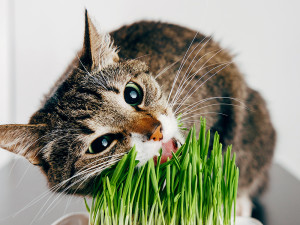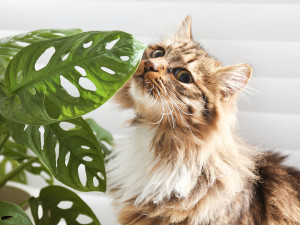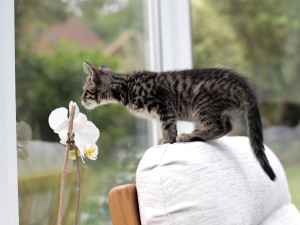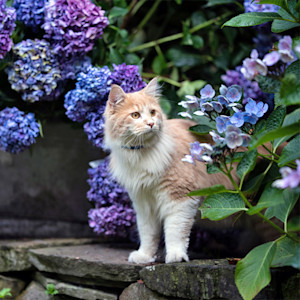Are Pothos Toxic to Cats? Find Out if Your Cat Can Eat Them
House plants are great, but so is keeping your cat safe.
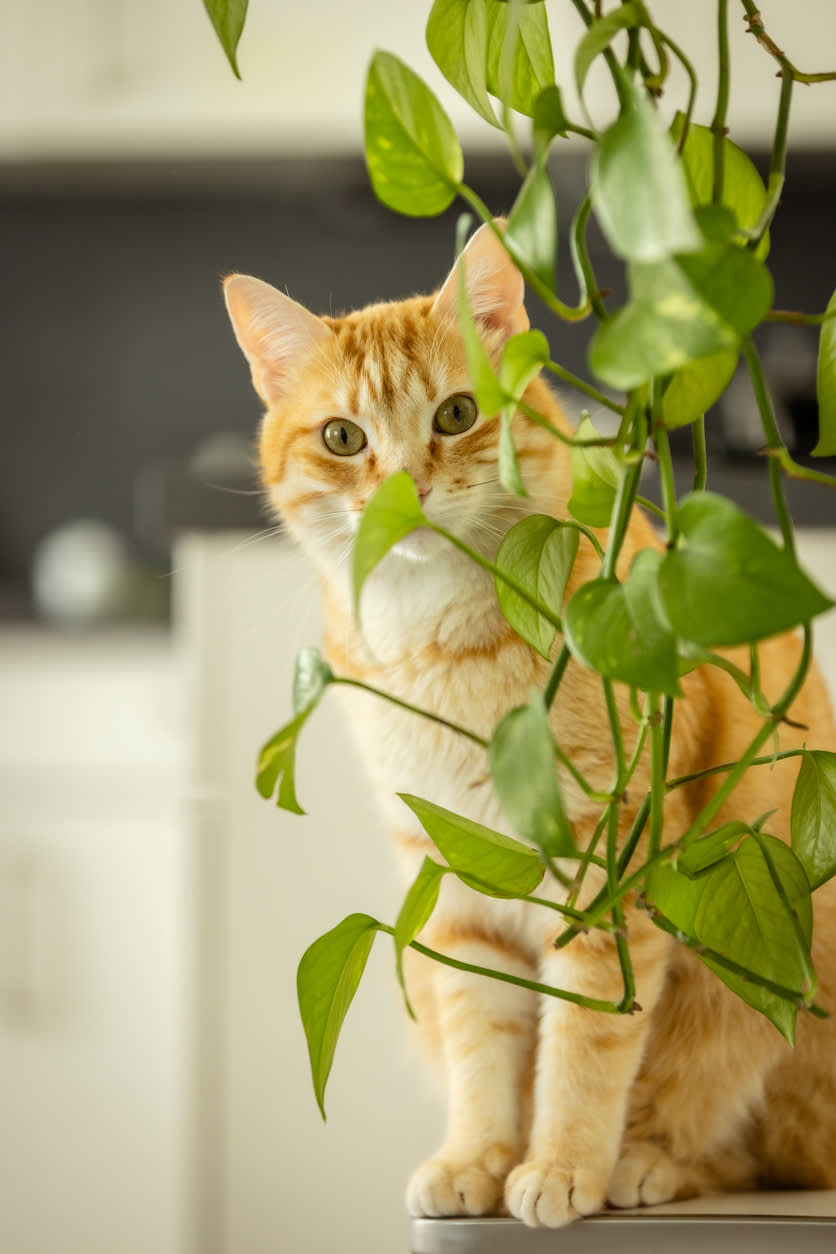
Share Article
In This Article:
What Is A Pothos Plant? Are Pothos Plants Toxic to Cats? Why Do Cats Eat Pothos? Symptoms of Pothos Poisoning in Cats What To Do If Your Cat Eats Pothos Cat-Friendly Plant Alternatives to Pothos
Cats are obligate carnivores and should be fed the way their ancestors ate: a diet of high protein, moderate fat, and low carbohydrates. Why, then, are they so interested in your houseplants? Maybe it’s just because they are curious because it certainly isn’t due to their needing plants in their diet.
One common houseplant is the pothos. Homeowners like it for its trailing vines and heart-shaped leaves. But if your cat likes it, too, you may wonder if the plant is toxic to cats. Many plants are, so let’s look into whether the pothos are safe for cats.
What is a pothos plant?
Pothos (Epipremnum aureum) is also known as Devil’s Ivy. It’s not just its beauty that makes it popular, but also its low maintenance. It will thrive in many indoor environments and do well in low-light conditions. The Pothos plant is available in several varieties and colors, each with unique leaf patterns. They are very adaptable and grow fast, appealing to new and experienced plant owners. They also are said to have air-purifying qualities.

Are pothos toxic for cats?
Unfortunately, the answer is an unequivocal yes. Pothos plants contain insoluble calcium oxalates, which are harmful if your cat eats them. Ingestion is rarely fatal but can cause significant discomfort for your kitty. Knowing about the possibility of health issues if your cat nibbles on the plant helps you be proactive in taking steps to prevent accidental exposure.
Why are pothos toxic to cats?
The insoluble calcium oxalate crystals are found throughout the pothos plant. All parts, including the leaves, stems, and roots, contain them and are toxic. The consequences of chewing on any part of the plant can cause irritation and swelling in the mouth, throat, and stomach.
The severity of the reaction can vary based on the amount of plant material ingested and the individual cat’s sensitivity. Even small amounts can cause noticeable discomfort, such as drooling or difficulty swallowing, while larger quantities may lead to more severe symptoms requiring medical intervention. Understanding the mechanics of pothos toxicity underscores the importance of keeping these plants out of your pet’s reach.
Why do cats eat pothos?
Cats may chew on pothos plants for several reasons:
Curiosity is a natural quality of cats, and they may nibble on a plant just to see what it is.
Texture and taste attract some cats. The smooth, glossy pothos leaves may appeal to cats, prompting them to chew on them.
Nutritional needs may sometimes be the cause of a cat trying to consume something they are deficient in, although being obligate carnivores, it’s unlikely that’s the reason.
Cats can actually get bored. They can turn to destructive behaviors if they are not mentally and physically engaged often enough. Always provide interactive playtime or safe plants to avoid this.
Like boredom, stress, or anxiety can lead a cat to chew on plants. Many things can stress a kitty, such as changes in the environment or people.
These are just a few of the reasons they may eat plants.
Symptoms of pothos poisoning in cats
The following is a list of symptoms that can occur if your cat should accidentally ingest pothos:
Drooling or excessive salivation
Vomiting
Difficulty swallowing
Pawing at the mouth
Swelling of the lips, tongue, or mouth
Any sign of discomfort
Decreased appetite
Lethargy or changes in behavior
Call your vet if you see any of these symptoms and suspect your cat has eaten part of a pothos plant.
How long does it take to make a cat sick from pothos?
It can take only minutes or hours for symptoms to appear after a cat eats pothos. The size of your cat and the amount of pothos they eat will determine the severity of symptoms. If you see or suspect your cat has ingested pothos, monitor closely and seek vet care if symptoms arise.
What to do if your cat eats pothos
If you discover that your cat has chewed on or ingested pothos, follow these steps:
Take the plant away from your cat immediately. Move the plant to a place where your cat can never reach it.
Rinse your cat’s mouth with water to remove any remaining plant material and to help reduce irritation. Try not to stress your cat further.
Watch for symptoms such as swelling, difficulty breathing, or vomiting. If symptoms worsen or persist, seek veterinary care immediately.
Call your veterinarian or an emergency animal-poison control center to tell them what has happened and ask what to do. Provide information about the plant and the symptoms your cat is experiencing. Early intervention can prevent complications.
Your veterinarian will tell you if you need to bring your cat into the hospital or give specific treatments. Only give what your vet tells you to.
Immediate action can help reduce the effects of pothos poisoning. Prevention is always better than treatment, so keep toxic plants where your cat can’t reach them.
Cat-friendly plant alternatives to pothos
If you’re a plant lover and have cats, you don’t have to give up your hobby. There are cat-safe plants. Here are a few:
Spider plant (Chlorophytum comosum): Non-toxic to cats and easy to care for. Many of its characteristics are similar to those of Pothos plants.
Areca palm (Dypsis lutescens): Looking for a tropical vibe? Areca palm is a larger plant and is safe for pets. It is visually appealing due to its feathery fronds.
Calathea: Also visually appealing due to its patterns and colors, it comes in different varieties. This plant is pet-friendly.
Boston fern (Nephrolepis exaltata): If you like hanging baskets or elevated planters, Boston Ferns may be just what you’re looking for. A lush and vibrant fern, it is safe for cats.
Cat grass: A mix of oat, rye, or wheatgrass specifically grown for cats to nibble on safely. It satisfies your cat’s urge to chew while providing a safe and healthy option.
So you see, you can have cats and plants if you choose the right ones. You can create a beautiful indoor garden by choosing non-toxic plants while protecting your kitty from harm. Additionally, consider using plant stands, shelves, or hanging pots to keep plants out of your cat’s reach.
You may really love the pothos plant, but I bet you love your cat more. Understanding the dangers of toxic plants and opting for cat-friendly plants will help you maintain a safe and happy environment for your pet. If you do your research, you can find many plants that are not toxic to pets. With careful planning, you can enjoy the beauty of houseplants without compromising your cat’s wellbeing.
Bottom line
If you have a desire to add houseplants to your decor, be aware that there are safe ones and others that are toxic to your cat. You must research which ones are toxic because they can make your cat severely ill. Call your vet immediately if your cat chews on a poisonous plant.
References
Grave, Tobias W, and Amanda K Boag. “Feline Toxicological Emergencies: When to Suspect and What to Do.” Journal of Feline Medicine and Surgery, vol. 12, no. 11, Nov. 2010, pp. 849–860, https://doi.org/10.1016/j.jfms.2010.09.006opens in new tab.
Petersen, Dan D. “Common Plant Toxicology: A Comparison of National and Southwest Ohio Data Trends on Plant Poisonings in the 21st Century.” Toxicology and Applied Pharmacology, vol. 254, no. 2, July 2011, pp. 148–153, https://doi.org/10.1016/j.taap.2010.10.022opens in new tab. Accessed 5 May 2021.
Siroka, Zuzana. “Toxicity of House Plants to Pet Animals.” Toxins, vol. 15, no. 5, 19 May 2023, p. 346, www.ncbi.nlm.nih.gov/pmc/articles/PMC10220692/opens in new tab, https://doi.org/10.3390/toxins15050346opens in new tab.

Dr. Shelby Neely, DVM
Dr. Shelby Neely is a freelance writer and veterinarian who graduated from the University of Pennsylvania School of Veterinary Medicine and has practiced veterinary medicine for 30 years, specializing in small animals. Her work has appeared in Allivet, AsktheCatDoctor, WhiskerDocs, Ask the Cat Doctor Radio, Ask the Cat Doctor TV, and numerous other websites, brochures, newsletters, newspapers, and ebooks. In her spare time, Dr. Neely likes to spend time with her three children, two grandchildren, three cats, two grand-cats, and five grand-dogs.
Related articles
![Cat playing in spider plant.]()
Are Spider Plants Toxic to Cats?
Learn what you should do if your “spider babies” and cat baby interact.
![Half-bengal kitten indoors smelling white orchid flowers in a conservatory.]()
Are Orchids Toxic to Cats?
Find out whether you can get that elaborate flower arrangement—or if you should skip it.
Are Ferns Toxic to Cats?
They’re great plants to brighten any home. But is your cat safe around them?
What Flowers Are Toxic to Cats?
Find out what you can and can’t plant in your garden.
![a cat peaking out from some hydrangeas]()
Are Hydrangeas Toxic to Cats?
They make your lawn look picture-perfect, but keep your cat away. Here’s why.
Why Does My Cat Eat Grass?
And should they?

